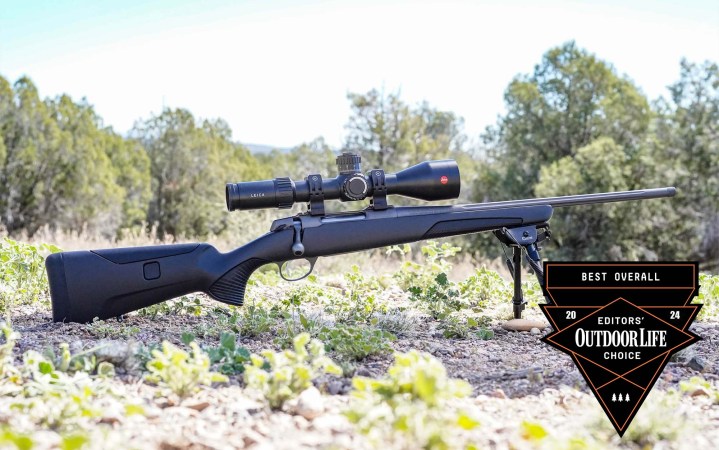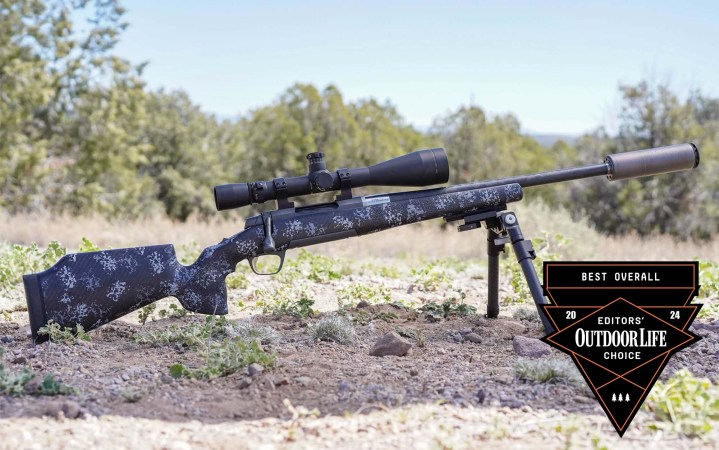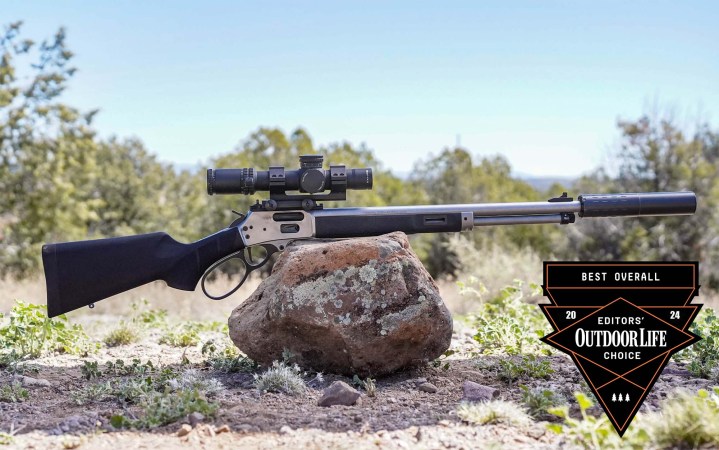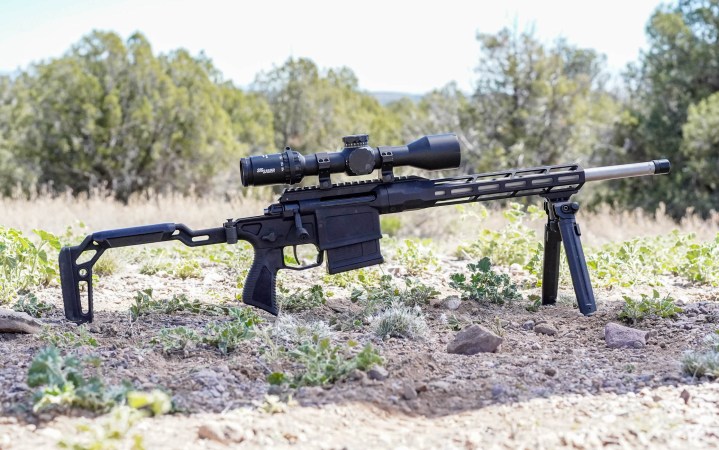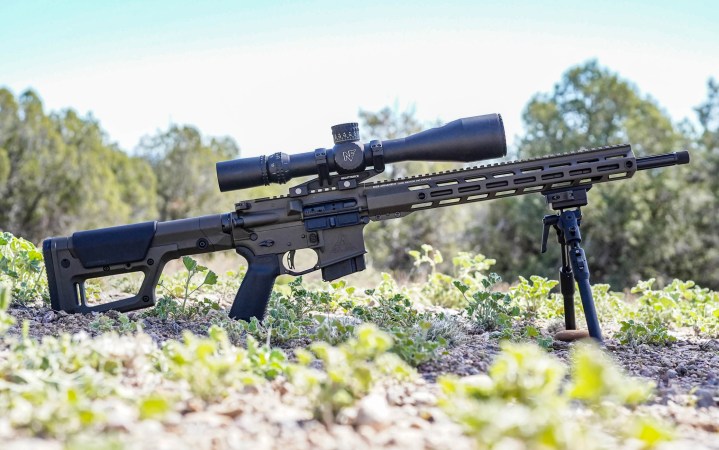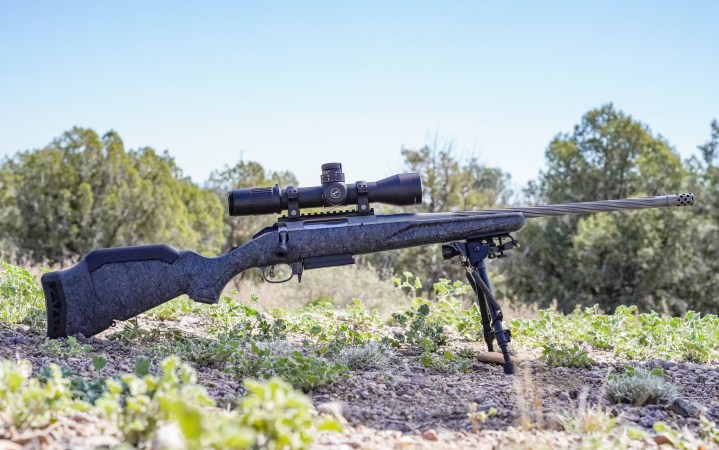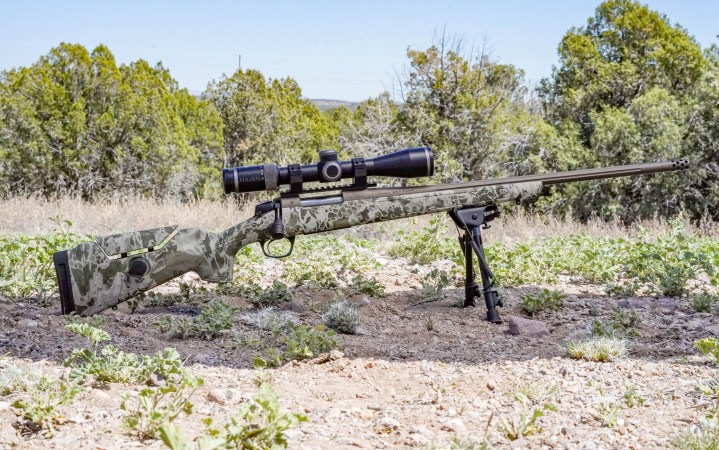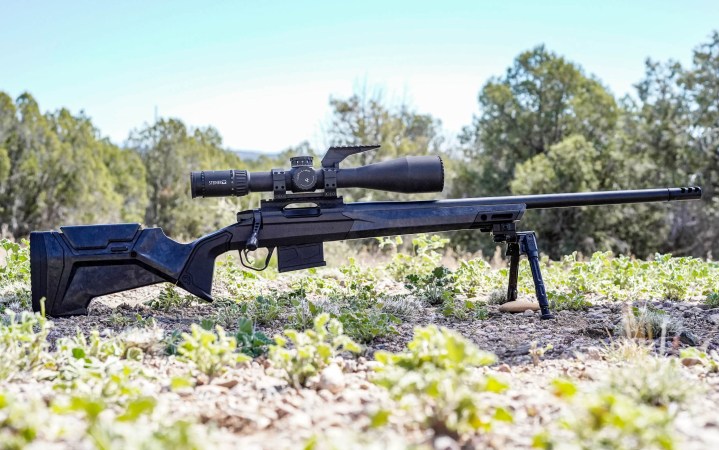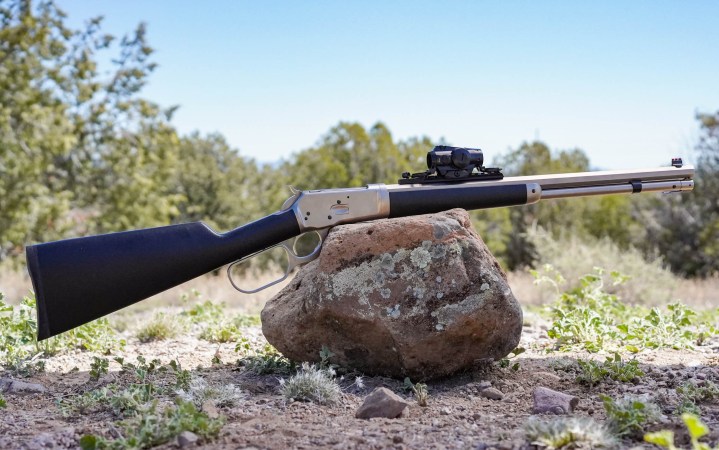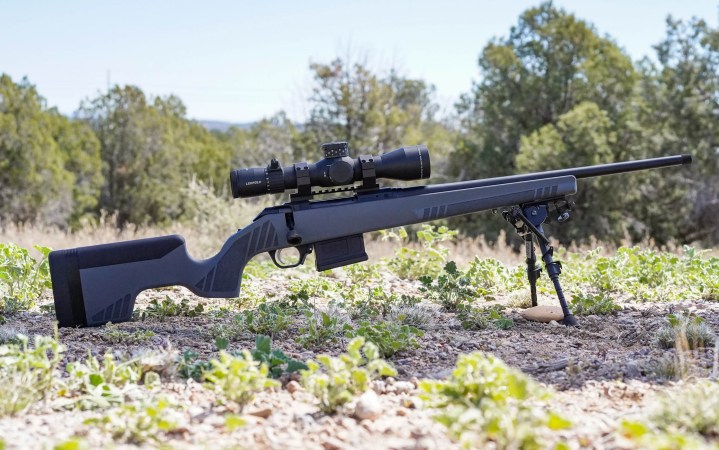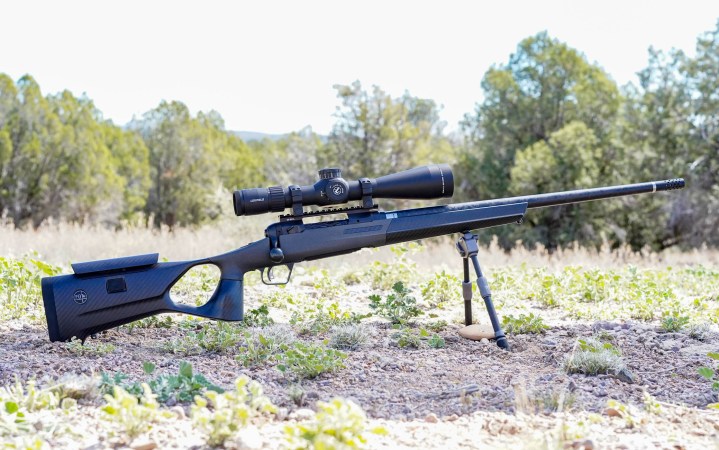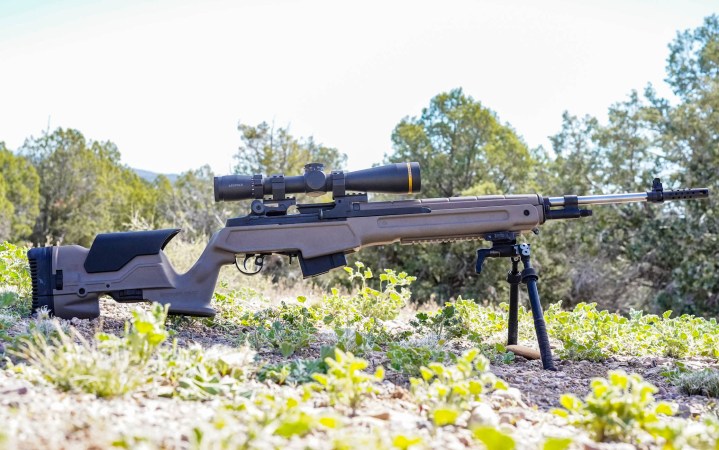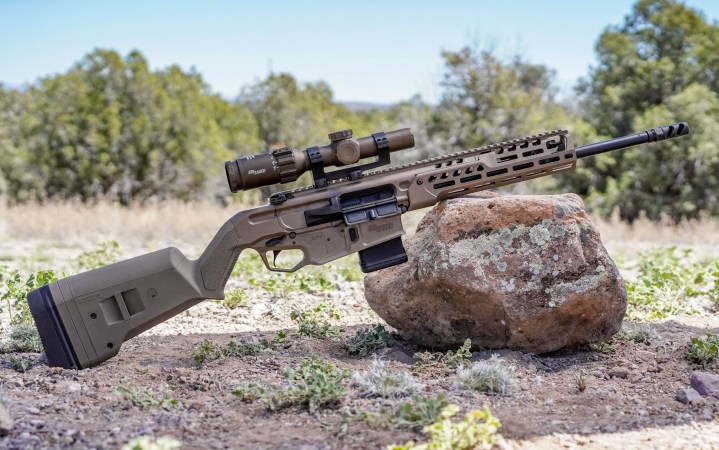The Best Rifles of 2024, Tested and Reviewed
We may earn revenue from the products available on this page and participate in affiliate programs. Learn More ›
Every year we assemble a pile of new firearms, an even bigger pile of ammunition, and fly or drive to a central location to test and review the best rifles of the year. It’s a massive undertaking unlike anything else in the hunting and shooting world.
Our home away from home for this is Gunsite Academy in Paulden, Arizona, which is the perfect venue to spend a week blasting away and jotting down notes about the latest and greatest guns. In addition to the best rifles, we also test the best handguns, and have run the top 1911s as well. This year we’ve added the best rimfires to the mix and will be doing a special test on Ruger 10/22s.
Best Rifles of 2024
This year we had a broad and diverse field of centerfire rifles that included several lever-actions, a number of ultralight mountain rifles, rifles chambered in the new 22 ARC, some semi autos, and some heavy-barreled long range guns. In other words, there’s something for everybody.
- Editor’s Choice Hunting Rifle: Sako 90S Adventure
- Editor’s Choice, Mountain Rifle: Browning X-Bolt 2
- Editor’s Choice, All-Around Rifle: Smith & Wesson Model 1854
- Innovation Award, Hunting Rifle: Seekins Havak Slam
- Innovation Award, Best New Cartridge: Proof Elevation MTR, 22 ARC
- Great Buy, Precision Rifle: Stag Pursuit
- Marlin Dark Series Model 1895
- Tikka T3x Drover
- Sig Cross Trax
- Rise Armament Watchman XR
- Beretta BRX1
- Ruger American Rifle Generation II
- CVA Cascade LRH
- Bergara Premier Series MgLite
- Christensen Arms Modern Hunting Rifle
- Chiappa 1892 Alaskan Takedown
- Colt CBX Tac Hunter
- Savage Arms 110 KLYM
- Springfield Armory M1A Loaded Precision
- Sig MCX Regulator
How We Tested the Best Rifles
What sets the Outdoor Life gun test apart from other gun reviews is the amount of data we gather and the way we judge the firearms. We have a panel of judges, experienced shooters all, who spend the week shooting the rifles for accuracy and who evaluate them during practical field drills, such as running them through Gunsite’s well-known Scrambler.
The test starts well before the first round of ammunition is fired, however. I spend several weeks gathering the guns, weighing them, measuring specs, scoping them up, and ensuring they are in tip-top condition for the rigorous week-long evaluation.
As part of this routine I rely heavily on my gunsmithing tool kit, to make sure all the fasteners are torqued correctly, the scopes are leveled, and everything is properly cleaned and lubricated. The best source for these items is Brownells, which has drivers, bits, torque wrench kits, and other essentials that I couldn’t function without.
A Note on Accuracy
We’re always looking to improve our firearms evaluations, and one area where we’ve evolved is how we gather and present accuracy data. We’ve always been a proponent of shooting multiple five-shot groups with lots of different types of ammunition. We’ve come to realize, however, that this standard is not rigorous enough.
So you’ll see a couple new data points in this year’s test based on 20-shot groups. One is the extreme spread of the groups, measuring the two shots that landed farthest apart, and the other is mean radius.
Mean radius is useful because it is a better predictive tool than just measuring group size. It is the average distance from the mathematical center of the group that each shot lands. So if a rifle has a .30-inch mean radius (which is excellent, by the way) that means on average, bullets from that rifle will impact .3 inches from the group’s center.
Photo by Ashley Thess
We’ll still publish five-shot group data, but savvy shooters are already embracing the benefits of 20-shot sample sizes and calculations like mean radius to ascertain how well their guns perform.
To gather this information we recorded 982 five-shot groups, which is a staggering amount of shooting. Our shoulders paid the price, but it allows us to stand behind the results in this test and look anyone — whether a first-time gun buyer or gun company CEO — squarely in the eye and know that we are providing an unbiased and defensible account of how these guns perform.
After reading this, we doubt you’ll ever look at a gun review based on a small number of three- or five-shot group data the same again.
How We Grade the Firearms
Each rifle is evaluated on nine categories and given a score of 1 to 5 from each judge, except for the accuracy score, which is based on the data from the groups shot. We average the scores for each category and use that to determine the ranking and awards. The categories are handling, accuracy, workmanship, aesthetics, ergonomics, meets purpose, versatility, reliability, and value.
These scores then translate to the grades on the report cards for each firearm. Performance consists of the scores from handling, accuracy, ergonomics, and reliability. Design includes workmanship, aesthetics, meeting its purpose, and versatility. Value stands on its own.
For accuracy, we’re publishing the average of all five-shot groups plus examples of the select 20-shot groups with extreme spread and mean radius data.
To earn an “Excellent” rating, the average of that score must be 4.5 or higher, a difficult mark to hit. “Very Good” is an average score of 3.5 to 4.5; “Good” is from 2.5 to 3.5; “Fair” is from 1.5 to 2.5; and “Poor” is under 1.5.
Best Rifles: Reviews and Recommendations
Editor’s Choice Hunting Rifle: Sako 90S Adventure
Report Card
- Performance: Excellent
- Design: Excellent
- Value: Very Good
- Total Five-Shot Group Average: .940 inches, 38 groups
- Accuracy Notes: This rifle shot everything well. We included three 20-shot aggregate groups below, which shows how average five-shot group size doesn’t necessarily translate to the 20-shot group results. The mean radius (the average shot distance from the mathematical center of the group) of all the ammo is excellent.
| Ammunition | 20-Shot E.S | Five-Shot Group Av. by Load | Mean Radius |
| Beger 144-gr LRHT | 1.05 inches | .806 inch | .31 inch |
| Federal 140-gr CtrStk | 1.64 inches | .861 inch | .32 inch |
| Sako 120-gr Powerhead | 1.13 inches | .672 inch | .25 inch |
Sako 90S Adventure Specs
- Action: Three-lug bolt
- Stock: Fiberglass and carbon fiber with adjustable cheekpiece
- Cartridge: 6.5 Creedmoor
- Capacity: 5+1
- Weight: 6 pounds 9 ounces (measured)
- Trigger: User adjustable from 2 pounds 1 ounce to 4 pounds 2 ounces (measured)
- Barrel: 20.1 inches, 1:8 twist, 5/8-24 thread adapter
- Length: 40.25 inches
- Price: $2,699

At first glance the Sako 90S Adventure looks like an ordinary bolt gun, with its synthetic stock, American Classic geometry, and sporter-weight barrel. As it turned out, this rifle is anything but run of the mill.
Each person on the gun test team came away impressed by the Sako 90S Adventure, which is one of seven new models in the 90 series that the Finnish gunmaker is introducing this year. The rifle’s ergonomics, craftsmanship, handling, and accuracy are exceptional. Collectively we felt this is about as good a traditional hunting rifle as any made. The price isn’t cheap, but in light of what you get, it is a heck of a value. This is one of those rifles that is built for hard hunting and should last generations.
Photo by Scott Einsmann
I did a full-blown review of the Sako 90 Adventure that gets into the weeds concerning its virtues, and also highlighted a couple minor drawbacks in its design. (Namely, that the stock should ditch the swivel studs and incorporate a recessed Picatinny rail along with QD attachment points. If it did both, the rifle would truly be perfect.)
During the accuracy phase of the evaluation, the Sako had an average five-shot group size of .940 inches across 38 groups with nine different types of ammo. The most impressive performance was from Sako’s 120-grain Powerhead Blade copper ammo, which averaged .672-inch five-shot groups, which is outstanding for non-lead ammunition.
Photo by Alex Robinson
By every metric, the Sako 90S Adventure is one of the best rifles of the year. It is a rifle that will give whoever wields it a justifiable sense of confidence. It is intuitive to run. It cycles with a smooth assurance. It is deadly accurate. And it handles great under field conditions. Combine all that and you’ve got our Editor’s Choice as the best rifle of 2024 in the hunting category.
Editor’s Choice, Mountain Rifle: Browning X-Bolt 2
Report Card
- Performance: Excellent
- Design: Very Good
- Value: Good
- Total Five-Shot Group Average: .719 inches, 73 groups
- Accuracy Notes: This is another phenomenally accurate rifle. When a rifle has a mean radius of .3 inches or less, it is a shooter.
| Ammunition | 20-Shot E.S | Five-Shot Group Av. by Load | Mean Radius |
| Federal 140-gr CtrStk | 0.68 inch | 0.605 inch | 0.24 inch |
| Federal 140-gr CtrStk | 1.14 inches | 0.709 inch | 0.31 inch |
| Federal 140-gr Fusion | 1.12 inches | 0.675 inch | 0.30 inch |
| Federal 143-gr ELD-X | 0.81 inch | 0.611 inch | 0.23 inch |
Browning X-Bolt 2 Pro McMillan Specs
- Action: Three-lug bolt
- Stock: McMillian Game Warden 2.0 foam-core carbon fiber
- Cartridge: 6.5 Creedmoor
- Capacity: 4+1
- Weight: 5 pounds 13 ounces (measured)
- Trigger: 3 pounds 2 ounces (measured)
- Barrel: 18 inches
- Length: 38.25 inches
- Price: $3,999
The only problem we had evaluating this rifle was figuring out who got to shoot it next. This lightweight wonder delivered otherworldly accuracy in 6.5 Creedmoor, and we have the receipts to prove it.
Staff writer Tyler Freel brought a new X-Bolt 2 to the gun test from his home in Fairbanks, Alaska. He’s been shooting the ever-loving snot out of it since he got his grubby mitts (his words, not mine) on this flagship model a couple months ago. He did a meaty review of the X-Bolt 2 that’s worth checking out, but the headline is that he loves it with the same passion Linus has for his blanket.
The rest of us on the gun team became equally smitten. All told, we put 73 five-shot groups through the rifle with 14 different loads. Of those, only five measured over an inch, with the largest being 1.128 inches. That’s amazing. The average of all the groups shot is .719 inches, making this one of the most accurate factory rifles we’ve ever tested.
Making this achievement more impressive is the rifle’s 5-pound 13-ounce weight. It’s one thing for a 13-pound competition gun to shoot lights out. It’s another for a mountain rifle with a carbon-fiber barrel to do the same.
The tube comes from Preferred Barrels that, like Browning, is based out of Utah. The stock is a McMillian carbon fiber Game Warden 2.0, which has a vertical pistol grip, ample flat-bottomed fore-end, and reverse slope comb.
The rifle has a smart feature set, including an integral 20 MOA Picatinny rail with a bubble level, QD sling attachment points, a Pic rail on the fore-end for a bipod, and a short 18-inch barrel that works well with a suppressor, which is how we shot it.
Photo by Tyler Free
The action is smooth, the magazine is Browning’s excellent rotary design, and by the end of the test we could find very little to criticize. (Though a recessed Pic rail on the fore-end would be more elegant and is one upgrade we’d love to see.) This is why it won our Editor’s Choice award as the best rifle of 2024 in the mountain rifle category.
One sticking point is the price. If you want to experience it for yourself, you’ll pay for the privilege. At $4,000 this rifle is out of reach of all but the well heeled. We aren’t saying the rifle isn’t worth it — quite the contrary. It’s just a shame that a rifle this impressive isn’t more attainable.
Editor’s Choice, All-Around Rifle: Smith & Wesson Model 1854
Report Card
- Performance: Very Good
- Design: Very Good
- Value: Excellent
- Total Five-Shot Group Average: 1.80 inches, 30 groups (50 yards)
- Accuracy Notes: The data here is with groups shot at 50 yards. With a mean radius of .5 inches you can be confident in tackling any game within the effective range of a .44 Magnum. This rifle more than meets the standard of the lever-action platform.
| Ammunition | 20-Shot E.S | Five-Shot Group Av. by Load | Mean Radius |
| Federal 300-gr CC | 1.87 inches | 1.304 inches | 0.52 inch |
Smith & Wesson Model 1854 Specs
- Action: Lever action
- Stock: Synthetic
- Cartridge: .44 Magnum
- Capacity: 9+1
- Weight: 6 pounds 12 ounces (measured)
- Trigger: 4 pounds 7 ounces (measured)
- Barrel: 19.25 inches; 1:20 twist; threaded 11/16-24
- Length: 36 inches
- Price: $1,279
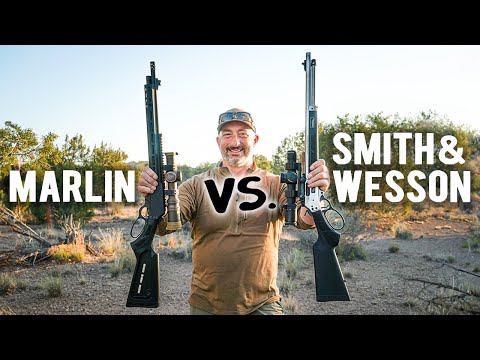
In my full-length review of the M1854 I describe it as the most remarkable rifle of the year. That Smith & Wesson was able to create such a fine lever-action rifle the first time the company dabbled in the platform is quite an achievement. On top of that, S&W configured the rifle smartly for the intended audience of close-range hunters and brought it to market at a competitive price.
The rifle has no real shortcomings. One tester felt the action was a bit mushy while cycling and another wasn’t a fan of the flat trigger — but those are two nitpicky observations from a field of hypercritical trigger monkeys.
Photo by Scott Einsmann
The rifle is chambered in .44 Mag, so it can also shoot .44 Special loads. Even with the hottest magnum rounds the rifle is well behaved and easy to control. The recoil isn’t bad at all. And when you drop down to .44 Special loads it becomes a complete pussy cat.
Among the rifle’s refinements that caught our eye were the clean, crisp trigger break; the smooth edges that make the rifle easy to load and comfortable to cycle; the tough synthetic stock with M-Lok slots in the fore-end for accessories; the ability to unload the rifle by removing the magazine tube and pouring out the rounds; and the threaded muzzle.
We did much of our shooting with the M1854 suppressed, turning it into “a giggle gun” in the words of one judge.
And indeed, the M1854 is fun. Perhaps that is its greatest virtue. Yes, it is a functional tool that will serve a shooter well as a survival rig, truck gun, or big woods whitetail blaster. But ultimately, it is a really fun gun to play with. And that’s why it won an Editor’s Choice award as the all-around best rifle of 2024.
Innovation Award, Hunting Rifle: Seekins Havak Slam
Report Card
- Performance: Very Good
- Design: Very Good
- Value: Good
- Total Five-Shot Group Average: 1.277 inches, 45 groups
- Accuracy Notes: For a rifle that weighs well under 6 pounds, the Slam shoots well. The rifle averaged 1.016-inch five-shot groups using Sako 136-gr Scenar. Because the barrel is so light, we also tested it with a series of three-shot groups with the Berger 140-grain Elite Hunter ammo. Those groups averaged .707 inches and when the groups were overlaid, the 20 shots had a 1.6-inch spread with a really good mean radius of .43 inches — a fine performance.
| Ammunition | 20-Shot E.S | Five-Shot Group Av. by Load | Mean Radius |
| Berger 140-gr EH | 1.59 inches | 0.707 inch | 0.43 inch |
Seekins Precision Havak Slam Specs
- Action: Four-lug bolt (two rows of two)
- Stock: Carbon fiber folder with aluminum bedding chassis
- Cartridge: 6.5 Creedmoor
- Capacity: 3+1
- Weight: 5 pound, 9 ounces (measured)
- Trigger: 1 pound 15 ounces (measured)
- Barrel: 20 inches
- Length: 42.25 inches (32.5 inches folded)
- Price: $4,650
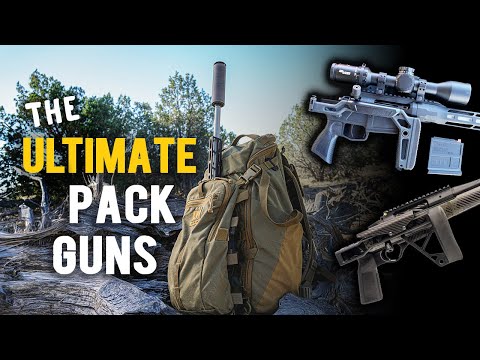
We’ve seen many rifles configured like the Seekins Slam of late: lightweight bolt actions with folding stocks that allow them to be stashed within a pack for easy and comfortable carry. But among this group — which includes the Sig Cross, Nosler Carbon Chassis Hunter, and Bergara Premier Series MgLite — none is as refined as this creation.
This nimble rifle is beautifully crafted with a stiff and elegant stock. The fore-end is trim and has a rail along the bottom with M-Lok slots and a QD mounting point. One of the rifle’s most interesting innovations is the addition of a small section of ARCA rail that’s been rotated 90 degrees so that the longer dimension is in line with the fore-end, which keeps the wings of the rail from jutting out on either side. It’s a small but thoughtful tweak.
To get to the rifle’s base 5.5-pound weight, Seekins trimmed away all excess. The carbon-fiber magazine is ultralight. The cheekpiece on the stock is a simple piece of carbon fiber that’s shaped a bit like a hard taco shell. It’s minimalistic but comfortable.
The buttstock is skeletonized but isn’t flimsy or insubstantial in any way. The hinge on the stock is tight and clicks into place in a positive manner. When folded it stays put and has a machined notch where the bolt handle goes.
The action is aluminum with steel added where the four bolt lugs lock up. The action has a 90-degree throw with dual lugs stacked two deep. The bolt throw is smooth and only after putting about 60 rounds through the rifle does it gum up a bit. But a quick wipe with a rag and some solvent or oil restores it to its slick, pristine state.
The rifle comes with an integral 20 MOA Picatinny rail, and to further reduce weight the raised portion of the rails are machined out a bit. Like everything else on the rifle it looks good but serves a purpose.
Photo by Scott Einsmann
The flat-bottomed action mates with an aluminum chassis embedded in the stock and is joined by two action screws with deep thread engagement.
In keeping with the best-in-class configuration of the build, the Slam comes with a Triggertech Diamond adjustable trigger, which is one of the finest available.
Overall accuracy with all ammo shot was 1.277 inches (45 five-shot groups with 11 types of ammo), though the rifle showed a preference for several loads. Among the standouts: Federal 140-grain Centerstrike (1.149 inch average); Sako TRG 136-grain Scenar (1.015 inch average); Sierra 140-grain MatchKing (.735 inch average); and Federal 143-grain ELD-X (1.142 inch average).
In sum, the Seekins Havak Slam is the finest expression of this type of firearm we’ve seen and is built with such insight and care that it earned an innovation award in the hunting rifle category.
Innovation Award, Best New Cartridge: Proof Elevation MTR, 22 ARC
Report Card
- Performance: Very Good
- Design: Very Good
- Value: Very Good
- Total Five-Shot Group Average: .864 inches, 32 groups
- Accuracy Notes: The accuracy of this rifle is very good, but it is limited by having only two loads to shoot through it. Both shot well, but on average the 88-grain ELD-M performed a little better. That said, there’s nothing shabby about the results of the 20-shot group with the 62-grain ELD-VT below.
| Ammunition | 20-Shot E.S | Five-Shot Group Av. by Load | Mean Radius |
| Hornady 62-gr ELD-VT | 1.40 inches | 0.869 inch | 0.34 inch |
Proof Research Elevation MTR Specs
- Action: Two lug bolt-action
- Stock: Carbon fiber
- Cartridge: 22 ARC
- Capacity: 5+1
- Weight: 7 pounds 3 ounces (measured)
- Trigger: 2 pounds 12 ounces (measured)
- Barrel: 20 inches
- Length: 39.75 inches
- Price: $3,499
The Elevation MTR isn’t a new rifle, but it is one of the first production guns chambered in 22 ARC, which is why we included it in this year’s field. I’ve gone into the details of the 22 ARC previously, but this was the first chance for the entire Outdoor Life gun test team to experience the hot-rod 22 round.
Based on the universal high scores the Proof MTR earned there’s a lot to like about this combo of rifle and cartridge.
Photo by Scott Einsmann
The rifle’s smooth action, manageable weight, compact length, and excellent ergonomics make it handle extremely well. The accuracy with the available factory ammo was quite good, with an average five-shot group size of .864 inches across 32 groups. The 88-grain ELD-M load outshot the 62-grain ELD-VT by about a tenth of an inch (.810-inch average versus .915 inches).
The 22 ARC should work well for varmints and deer-sized game and, thanks to its low recoil and flat trajectory, is a good option on steel, too.
One area we think that this rifle could improve is with the stock design. The dual swivel studs on the fore-end were a good choice back in 2005, but at this point a high-performance bolt action that costs $3,500 should come with either an ARCA or Picatinny rail to attach a bipod and QD cups for the sling. There are rails you can add on yourself, but that’s a bit pesky.
Great Buy, Precision Rifle: Stag Pursuit
Report Card
- Performance: Very Good
- Design: Very Good
- Value: Very Good
- Total Five-Shot Group Average: 1.087 inches, 34 groups
- Accuracy Notes: Compare this rifle to the Seekins Havak Slam and you’ll see the results are nearly identical. That said, when you look at all the ammo we put through this rifle you’ll notice it shoots tighter than the Slam, which is what you’d expect with a precision platform compared to a mountain rifle. The average of all five-shot groups was 1.087 inches, which shows this is a very consistent shooter.
| Ammunition | 20-Shot E.S | Five-Shot Group Av. by Load | Mean Radius |
| Berger 140-gr EH | 1.59 inches | 0.706 inch | 0.43 inch |
Stag Arms Pursuit Specs
- Action: Three-lug bolt
- Stock: Synthetic
- Cartridge: 6.5 Creedmoor
- Capacity: 5+1
- Weight: 8 pounds 15 ounces (measured)
- Trigger: 2 pounds 14 ounces (measured)
- Barrel: 20 inches, 1:8 twist, threaded 5/8-24
- Length: 39.75 inches
- Price: $1,899
It did my heart good to have the Stag Arms Pursuit in the mix this year, as it combined two of my favorite things: long range accuracy and a good value.
The Pursuit is a heavy-barreled three-lug bolt action mated to a chassis with a polymer fore-end and grip/buttstock. The action is smooth and easy to operate and stayed slick no matter how many rounds we put downrange.
While a couple judges didn’t care for the blocky look of the stock, that aesthetic didn’t have an impact on the rifle’s performance. We had nothing but praise for how it handled while shooting prone and from various supported positions.
The rifle gives the shooter superlative feedback, meaning that if you’re focused during the trigger break and follow-through, the rifle will tell you precisely what happened downrange. It’s one of those rifles that makes it easy to call shots.
The general ergonomics of the Pursuit are really good as well. The undercut buttstock lets you control how much pressure your shoulder exerts on the recoil pad and fine-tune your reticle hold. The comb adjusts for height. The mag catch at the front of the trigger guard is slightly oversized and easy to manipulate. The trigger, safety, and generously-proportioned bolt handle are all comfortable and intuitive to operate.
Photo by Scott Einsmann
The spiral fluted barrel gives the rifle a bit of flair and the muzzle is threaded 5/8-24. A section of Picatinny rail with six slots extends off the front of the fore-end for mounting a bipod, and the stock has a series of M-Lok slots on the underside of the fore-end as well. The rifle has multiple QD attachment spots for a sling.
The butt stock can also be removed from the rifle by drifting out a single takedown pin and potentially swapped out for another design. The rifle also has captured action screws, which is a nice feature. The bolt can be taken down without tools.
It shot really well from the 100-yard line and during the practical portion of the evaluation. Plenty of different types of ammo averaged under an inch with five-shot groups — AAC 140-grain SMK (.888 inches), Berger 130-grain Hybrid OTM (.923 inches), Federal 140-grain Berger Hybrid (.964 inches), Federal 140-grain OTM (.903 inches). The overall average of all ammo shot (34 groups with nine types of ammo) was 1.036 inches.
All told, this amounts to an impressive feature set that delivers on performance and is the reason the Pursuit won a Great Buy award in the Precision Rifle category.
Marlin Dark Series Model 1895
Report Card
- Performance: Very Good
- Design: Very Good
- Value: Very Good
- Total Five-Shot Group Average: 1.284 inches, 24 groups (50 yards)
- Accuracy Notes: As with the other lever-actions, this data is from 50 yards while standing and shooting off a support bag on a tripod. We were all really impressed with how well the Barnes 300-grainers shot. In .45/70 it delivers a devastating wallop, whether you’re chasing deer in the timber or trying to stop a grizzly charging at you from a willow thicket.
| Ammunition | 20-Shot E.S | Five-Shot Group Av. by Load | Mean Radius |
| Barnes 300-gr TSX | 0.99 inch | 0.892 inch | 0.36 inch |
Marlin Dark Series Model 1895 Specs
- Action: Lever action
- Stock: Synthetic butt with aluminum handguard
- Cartridge: .45/70 Gov’t
- Capacity: 5+1
- Weight: 6 pounds 13 ounces (measured)
- Trigger: 6 pounds 4 ounces (measured)
- Barrel: 16.17 inches, 1:20 twist, threaded 11/16-24
- Length: 35.5 inches
- Price: $1,429
I’ve been curious to see whether Marlin might run out of steam with its flurry of new introductions but the answer to that question so far is a resounding “no.” The 1895 Dark Series is the first production gun from Marlin that falls under the tactical lever action umbrella and is more than just a gimmicky upgrade to the iconic lever gun.
Photo by Scott Einsmann
The stock is the most notable change from prior 1895s and, while this might come as a surprise to some readers, it is the first factory Marlin centerfire lever action to have a stock made of something other than wood.
The butt is nylon-reinforced polymer that is thinned out in the middle and pays homage the iconically ugly (and beloved) boat paddle Zytel-stocked Ruger M77 of years past. The thin portion has three M-Lok slots to add items like cartridge carriers. A beefed-up portion sports QD attachment points, and the recoil pad is pretty stout.
The fore-end looks like an AR-style handguard, and has an octagonal shape with more M-Lok slots that you could possibly need, along with two QD cups.
The fat recoil pad is a good thing, because when running potent .45-70 rounds the rifle definitely bucks. We didn’t have a hard time controlling the rifle, but it is a different beast than the other lever guns in the test, which were chambered in .44 Magnum.
Marlin configured this rifle with an attractive feature set beyond the stock. The receiver has a Picatinny rail that extends halfway up the fore-end and makes mounting optics a simple exercise. The rail also comes with a ghost-ring rear sight to compliment the bright green fiber-optic sight up front. We did the bulk of our shooting with a Nightforce 1-8 LPVO on board.
The 16.1-inch barrel is threaded 11/64-24 and includes a radial muzzle brake which is probably effective, but we ditched it in favor of a suppressor before we started the shooting.
The rifle has a mid-sized lever loop, which is more functional than the oversized loops that everyone seems to like. The whole rifle is finished in a graphite black Cerakote that looks purposeful and pretty badass.
When you run the gun hard — and we ran it like we stole it — the aluminum handguard can get seriously hot, but for normal use that won’t be an issue.
This is another impressive rifle from the resurrected Marlin, one that will appeal to new shooters and might even persuade a traditional lever gun person to move to the dark side.
Tikka T3x Drover
Report Card
- Performance: Very Good
- Design: Very Good
- Value: Very Good
- Accuracy Notes: From the 50-yard line with open sights this rifle averaged 1.865-inch groups, shooting three different types of ammo. As I mention below, we plan to do a full review of this rifle with a scope attached and will update this story with that data once we collect it. Since we knew the rifle wasn’t shooting to its actual potential we didn’t gather the same 20-shot data for it, but we’ll have that in the future.
Tikka T3x Drover Specs
- Action: Bolt
- Stock: Synthetic
- Cartridge: .308 Winchester
- Capacity: 10+1
- Weight: 6 pounds 10 ounces (measured)
- Trigger: 3 pounds 7 ounces (measured)
- Barrel: 20 inches, 1:11 twist
- Length: 40.25 inches
- Price: $1,299
This rifle is built for a specific niche of hunters: namely those in Europe who take on driven game. It is a fast handling .308 that holds 10 rounds and comes with excellent fiber-optic open sights.
This rifle quickly became one of the darlings of the test. All the things that make so many hunters and shooters hold Tikka in high regard are present in the Drover. Its performance, accuracy, value, workmanship, and fun-factor are undeniable.
I need to qualify its accuracy, however. Because we didn’t have an optic to mount on the rifle — it requires a special mount — we shot it only with the iron sights. We had no issue keeping it on vital-zone sized targets at 100 yards, but when compared to the scoped rifles in the field, it naturally didn’t score as well. (This is one reason we plan to do a full review of this rifle in the future with a scope.)
Photo by Scott Einsmann
The Drover’s ergonomics and handling are excellent. The magazine loads easily, slips in and out of the mag well with no issues, the action cycles smoothly, and the rifle is quick to get on target. It is also a terrific value.
With a quick-detach scope attached we could see this rifle performing numerous roles: everyday truck gun, palmetto-thicket hog slayer, big timber deer rifle — basically anything where a tough, accurate .308 is called for.
Sig Cross Trax
Report Card
- Performance: Very Good
- Design: Good
- Value: Very Good
- Total Five-Shot Group Average: 1.349 inches, 16 groups
- Accuracy Notes: Across all types of ammunition the Cross Trax averaged 1.349-inch groups, which isn’t bad considering how unpleasant it is to shoot prone. But it did shoot some loads, which I detail below, very well. And, really, this rifle shines in practical field positions; we’d have no reservations about taking it on a mountain hunt.
| Ammunition | 20-Shot E.S | Five-Shot Group Av. by Load | Mean Radius |
| Freedom Munitions 155-gr Pro Match | 1.64 inches | 1.141 inches | 0.44 inch |
Sig Cross Trax Specs
- Action: Three-lug bolt action
- Stock: Chassis folder
- Cartridge: .308 Winchester
- Capacity: 5+1
- Weight: 6 pounds 1 ounce (measured)
- Trigger: 3 pounds 10 ounces (measured)
- Barrel: 16 inches, 1:10 twist, threaded 5/8-24
- Length: 35.25 inches (26.25 inches folded)
- Price: $1,499
This is a tale of two guns. During the first portion of the test we gather accuracy data while shooting all the rifles prone at 100 yards. Over those first couple of days, no one was a fan of the Sig Cross Trax, which is a more minimalistic version of the company’s popular (and excellent) Sig Cross.
The stripped-down butt stock and overall light weight made for an unpleasant ride for whoever settled in behind the rifle, even in the moderate .308 Winchester. The exercise of gathering that five-shot group data was necessary and useful, however.
The rifle shined with some types of ammunition and didn’t seem to care for others. The three loads it liked best were Berger 175-grain OTMs (.962-inch average), Freedom Munitions 155-grain Pro Match (1.141-inch average), and Sierra 168-grain MatchKings (1.127-inch average).
But our sour disposition toward the rifle vanished once we started running it in practical shooting drills.
Photo by Scott Einsmann
The Cross Trax is handy and well-balanced, and we found it nicely mannered while shooting from supported positions and offhand. The short and snappy bolt throw (the rifle has a three-lug action) helped us get accurate shots downrange quickly. Likewise, the rifle’s solid ergonomics made it intuitive to run. (The grip, safety, handguard and other features mimic the geometry of AR-15 style rifles.)
The rifle comes with a full-length Pic rail on the receiver, has a threaded muzzle, M-Lok slots on the handguard, and QD sling attachment points.
Mastering the technique to fold the stock takes a little bit of practice, but in the open position the buttstock is solidly locked in place and doesn’t wiggle. In the closed position it is the most compact (26 inches) of the three folders in the test.
It is also the best value of those rifles by a long shot. As much as we swooned over the Seekins Slam ($4,650) and were wowed by the Bergara MgLite’s accuracy ($3,099), the $1,400 price tag on the Sig Cross Trax makes it the everyman’s pick in the category.
Rise Armament Watchman XR
Report Card
- Performance: Good
- Design: Very Good
- Value: Good
- Total Five-Shot Group Average: 1.408 inches, 26 groups
- Accuracy Notes: This rifle had a definite preference for the 88-grain ELD-M load. The average group size of 16 groups with the 88s was 1.243 inches, while the average of 10 groups with the 62-grain ELD-VT was 1.673 inches.
| Ammunition | 20-Shot E.S | Five-Shot Group Av. by Load | Mean Radius |
| Hornady 88-gr ELD-M | 2.04 inches | 1.169 inches | 0.57 inch |
Rise Armament Watchman Specs
- Action: Semi auto
- Stock: Synthetic
- Cartridge: 22 ARC
- Capacity: 10
- Weight: 8 pounds 2 ounces (measured)
- Trigger: 3 pounds 8 ounces (measured)
- Barrel: 18 inches, 1:7 twist, threaded ½-28
- Length: 37.25 inches
- Price: $2,099
We were pretty excited to get our hands on this gas gun from Rise Armament. We’ve had excellent experiences with their products in the past and our sample was chambered in Hornady’s new 22 ARC, a cartridge designed to excel in semi autos of this type. It wasn’t quite the match made in heaven we hoped for, however.
The rifle itself is nicely made with quality finishes and a very good handguard. It comes with Rise’s Iconic Independent Two-Stage Trigger, which is excellent, though we did have some issues with it not resetting properly from time to time resulting in a heavy trigger pull.
The Magpul PRS Lite butt is the perfect companion to the platform and was a boon to the rifle’s ergonomics.
The lack of an adjustable gas block is the biggest shortcoming on the gun. The factory 22 ARC ammo ran the gun too hard, especially when we added a suppressor to the rifle, which is something many (if not most) 22 ARC shooters will be prone to do.
Photo by Alex Robinson
Because it was so overgassed the rifle beat the snot out of the brass empties, rendering many of them incapable of being reloaded, which was a bummer.
The accuracy of the ammunition was markedly diminished compared to the results we got from the Proof Elevation MTR. The average five-shot group with the 88-grain ELD-M was 1.243 inches, while the groups with the 62-grain ELD-VT averaged 1.673 inches.
We’d love to see this rifle configured in a more purpose-built fashion for the 22 ARC, able to be tuned to an appropriate level, and hopefully shoot a bit tighter too.
Beretta BRX1
Report Card
- Performance: Good
- Design: Good
- Value: Very Good
- Total Five-Shot Group Average: 1.179 inches, 26 groups
- Accuracy Notes: The BRX1 was a very good shooter, and was able to average sub-1-inch five-shot groups with multiple types of ammo, including the Sako 120-grain Powerhead Blade (.821 inches), Sierra 140-grain MatchKings (.906 inches), AAC 140-grain SMK (.869 inches), and the Hornady 147s in the chart below.
| Ammunition | 20-Shot E.S | Five-Shot Group Av. by Load | Mean Radius |
| Hornady 147-gr ELD-M | 1.37 inches | 0.698 inch | 0.38 inch |
Beretta BRX1 Specs
- Action: Straight-pull, 8-lug rotary bolt
- Stock: Synthetic
- Cartridge: 6.5 Creedmoor
- Capacity: 5
- Weight: 7 pounds 13 ounces (measured)
- Trigger: 2 pounds 7 ounces (measured)
- Barrel: 22 inches, 1:8 twist, threaded M14
- Length: 43.25 inches
- Price: $1,599
This is the most distinct new rifle of 2024. It has a lot of clever design elements rolled into an effective hunting rig and is a good option should a driven hunt be in your future.
It is a straight-pull action with a manual three-position cocking system. The action is fed by one of the best-designed magazines we’ve seen. And when I say, “seen” I’m not fooling around. It has a blaze-orange plastic body that makes it all but impossible to lose in the brush or misplace in your gear bag, which is something we really liked.
The magazine’s release mechanism is built into the magazine itself, which eliminates the latches, levers, or other hardware that rifles typically need to accommodate their magazines. The magazine also loads very easily, which we appreciated too.
We did have an issue with some ammo hanging up in the action causing it to bind up when running it off a bag on a tripod. This seemed to be ammunition specific, but it did cost the rifle some points in the test.
Photo by Alex Robinson
We were pleased with how well the rifle tracked during our shooting from the prone position, and the fact that the action can be swapped from right- to left-handed operation is another feather in the cap for the BRX1 design team.
Straight pulls are still a novel idea for American sportsmen, so it isn’t clear how eagerly rank-and-file hunters will take to the platform. But at $1,600 it is fairly attainable and, depending on how and where a person hunts, this Beretta should find some eager early adopters.
Ruger American Rifle Generation II
Report Card
- Performance: Good
- Design: Good
- Value: Very Good
- Total Five-Shot Group Average: 1.088 inches, 37 groups
- Accuracy Notes: As with the original Ruger American Rifle, the Generation II is a shooter. The overall average five-shot group with 37 groups and 14 types of ammo was 1.088 inches. It is impressively consistent, but it shot some ammo exceptionally well.
| Ammunition | 20-Shot E.S | Five-Shot Group Av. by Load | Mean Radius |
| Berger 130-gr HOTM | 1.30 inches | 0.597 inch | 0.36 inch |
Ruger American Rifle Generation II Specs
- Action: Bolt
- Stock: Synthetic
- Cartridge: 6.5 Creedmoor
- Capacity: 3+1
- Weight: 6 pounds 8 ounces (measured)
- Trigger: 4 pounds 2 ounces (measured)
- Barrel: 20 inches, 1:8 twist, threaded 5/8-24
- Length: 40.25 inches
- Price: $729
Photo by Scott Einsmann
In 2010 when Ruger introduced the Ruger American Rifle, it gained immediate traction with hunters. It combined excellent accuracy and good ergonomics at an attractive price and has been one of the most successful rifles of the last couple decades. With the Generation II released in 2024, Ruger built on the success of the original by adding numerous useful upgrades to the platform, along with some refinements.
When I reviewed the Ruger American Gen II earlier this year, I called out the ambidextrous three-position safety, better aesthetics, and modular stock as some of the rifle’s notable changes.
It turned in some screaming good groups at the range, and really liked Berger’s 130-grain Hybrid OTM (.597-inch five-shot group average) and Federal 140-grain Fusions (.755-inch average five-shot group).
The test team generally agreed that this is a capable hunting rifle at a good price and is a worthy successor to the OG American Rifle.
CVA Cascade LRH
Report Card
- Performance: Good
- Design: Good
- Value: Good
- Total Five-Shot Group Average: 1.194 inches, 21 groups
- Accuracy Notes: The Cascade LRH turned in solid results during the accuracy portion of the gun test, including some really impressive groups with certain ammo. As with many of the 6.5 Creeds in the test, it loved the Berger 130-grain Hybrid OTMs, turning in a 20-shot group just north of 1 inch.
| Ammunition | 20-Shot E.S | Five-Shot Group Av. by Load | Mean Radius |
| Berger 130-gr HOTM | 1.02 inches | 0.746 inch | 0.31 inch |
CVA Cascade LRH Specs
- Action: Bolt
- Stock: Synthetic
- Cartridge: 6.5 Creedmoor
- Capacity: 4+1
- Weight: 8 pounds 7 ounces(measured)
- Trigger: 2 pounds 10 ounces (measured)
- Barrel: 22 inches, 1:8 twist, threaded 5/8-24
- Length: 44 inches
- Price: $925
This was the lone long-range hunting rifle in this year’s test. Usually, we have a number of entries in this category. The CVA Cascade LRH is a heavy (8.5 pounds) and solid rifle that was a pleasure to shoot prone. It tracked well and absorbed recoil like a champ.
The Cascade is an unrefined working tool that delivers a lot of punch for the money. It has an adjustable cheek piece to tune the stock fit. The stock also has a rubberized coating that will give a secure handhold under any condition.
While it doesn’t have supermodel looks, we did like the rifle’s camo pattern, which elevates it from the world of plain black stocks. The finish on the metalwork is evenly applied and is pretty good for a rifle at this price, too.
The rifle comes with dual swivel studs on the fore-end for a bipod and has an effective radial muzzle brake. We did notice the stock has a bit of flex when you put pressure on it, such as when loading a bipod, but that’s not uncommon for sub-$1,000 rigs.
The double-stack magazine functioned well and was able to be top-loaded, which is a good quality. The trigger guard has ample room for a gloved finger. The trigger broke crisply at 2 pounds 10 ounces.
As one would hope for a long-range hunting rifle, the accuracy was very good. The overall five-shot group average was 1.194 inches (21 groups with eight types of ammo). There were a couple standouts. The Berger 130-grain Hybrid OTMs (one of the best-shooting loads in the test) averaged .746 inches, while Federal’s 143-grain ELD-X came in at .790 inches.
Bergara Premier Series MgLite
Report Card
- Performance: Very Good
- Design: Good
- Value: Fair
- Total Five-Shot Group Average: .912 inches, 28 groups
- Accuracy Notes: I gush about this rifle’s accuracy below, but it is worth iterating how impressively it shoots for a light rifle. That it is able to produce a .8-inch 20-shot group while tipping the scales at 6.25 pounds is remarkable.
| Ammunition | 20-Shot E.S | Five-Shot Group Av. by Load | Mean Radius |
| Berger 130-gr HOTM | .82 inch | 0.580 inch | 0.25 inch |
Bergara Premier Series MgLite Specs
- Action: Bolt-action
- Stock: Chassis folder
- Cartridge: 6.5 Creedmoor
- Capacity: 5
- Weight: 6 pounds 3 ounces (measured)
- Trigger: 3 pounds 6 ounces (measured)
- Barrel: 22 inches, 1:8 twist, threaded 5/8-24
- Length: 38 inches (27.75 inches folded)
- Price: $3,099
Photo by Alex Robinson
Our feelings about this rifle were mixed, but one thing we all agreed on is that it is a shooter. Among the lightweight folders in the test, it turned in the best groups on the range.
The rifle’s overall accuracy averaging 28 five-shot groups using eight types of ammo was .912 inches, which is pretty amazing for a rifle that weighs 6 pounds 3 ounces. Among the best shooting loads were the Berger 130-grain Hybrid OTM (.634 inches), Federal 143-grain ELD-Xs (.747 inches), Sierra 140-grain HPBT (.784 inches), and the Sako 120-grain Powerhead Blade (.803 inches).
You can’t argue with performance like that, and we have to give a lot of credit to the rifle’s CURE carbon-fiber barrel for these results. When it came to the rifle’s aesthetics and design, however, we weren’t as bullish.
The rifle mates Bergara’s two-lug Premier action, which has a floating bolt head and spring-loaded sliding plate extractor, with an XLR Element 4.0 Chassis. The chassis is made of magnesium, has a folding stock, and includes touches such as an integral ARCA rail along the bottom of the fore-end, adjustable cheek piece, and embedded bubble level so you can check your rifle’s cant before breaking a shot. All good things.
That said, the hinge on the chassis is loose and floppy and it doesn’t lock or secure the buttstock in any way when folded. The magazine catch is difficult to get at. It has a mishmash of holes, slots, and exposed screw heads. And it uses a bunch of discordant finishes and materials that don’t hang together from a visual standpoint. Also, when the action and chassis are joined, the bolt handle and bolt notch don’t match up.
None of these are fatal flaws, but they give the rifle a thrown-together look. For $3,000 we expect something more refined and cohesive.
Christensen Arms Modern Hunting Rifle
Report Card
- Performance: Very Good
- Design: Good
- Value: Fair
- Total Five-Shot Group Average: 1.224 inches, 23 groups
- Accuracy Notes: The MHR is a solid shooter that consistently averaged 1- to 1.3-inch five-shot groups with most of the ammunition we tested it with. It definitely took a shine to the Freedom Munitions 140-grain BTHP, which has been a standout load for us in the past.
| Ammunition | 20-Shot E.S | Five-Shot Group Av. by Load | Mean Radius |
| Freedom 140-gr BTHP | 2.11 inches | 0.898 inch | 0.53 inch |
Christensen Arms MHR Specs
- Action: Bolt
- Stock: Hybrid aluminum chassis and carbon fiber
- Cartridge: 6.5 Creedmoor
- Capacity: 5+1
- Weight: 7 pounds 11 ounces (measured)
- Trigger: 4 pounds 1 ounce (measured)
- Barrel: 22 inches, 1;8 twist, threaded 5/8-24
- Length: 45 ½ inches
- Price: $3,499
This is one of the cooler-looking new rifles of 2024 and one of the slickest to boot. The action on this rifle is glass-smooth and makes the rifle cycle effortlessly. One of the distinguishing features of the MHR is a modular design that lets you swap grips and change between an internal magazine and a detachable box mag.
Even though the rifle is constructed with lots of carbon fiber, it weighs in at 7 pounds 11 ounces, which is typical for a big-game rifle. That weight gives the rifle greater stability and makes it solid from practical field positions. The trigger on our sample broke at 3 pounds 4 ounces, which is also a good middle-of-the-road weight for a big-game rig.
The rifle ships with a large and effective muzzle brake but we pulled that early in the evaluation and ran it with suppressors for the bulk of the test.
We really liked the design of the fore-end, which has a recessed Picatinny rail and three QD attachment points. One thing we didn’t care for was how the five-round polymer magazine the rifle shipped with rattles around in the mag well. We all found it distracting.
Its accuracy was good (1.224-inch five-shot group average) but not jaw-dropping, though it did meet Christensen’s accuracy guarantee with select loads.
A question mark that hangs over the MHR is who is it for, exactly? Unlike other expensive carbon-fiber rifles it isn’t a lightweight rig for the mountains. And at $3,500 it is going head-to-head with a host of excellent rifles.
Chiappa 1892 Alaskan Takedown
Report Card
- Performance: Good
- Design: Good
- Value: Fair
- Total Five-Shot Group Average: 2.542 inches, 19 groups
- Accuracy Notes: The data here is based on shooting at 50 yards with open sights while using a tripod and shooting bag from the standing position. The overall average of the five-shot groups we put through the rifle measured 2.542 inches, which isn’t shabby for a ghost-ring setup. As with the Smith M1854, the Federal 300-grain ColdCast load shot the tightest.
| Ammunition | 20-Shot E.S | Five-Shot Group Av. by Load | Mean Radius |
| Federal 300-gr CC | 2.79 inches | 1.937 inches | 0.81 inch |
Chiappa 1892 Alaskan Takedown Specs
- Action: Lever-action
- Stock: Rubber-coated walnut
- Cartridge: .44 Magnum
- Capacity: 10
- Weight: 7 pounds 3 ounces (measured)
- Trigger: 4 pounds 7 ounces (measured)
- Barrel: 20 inches, 1:20 twist
- Length: 38.25 inches
- Price: $1,813
Photo by Scott Einsmann
This groovy lever-action is built for the modern cowboy. It is based on the classic Winchester ’92, which was one of John Browning’s many brilliant designs. The hallmark of the Model 1892 was its ability to pack a punch with pistol-caliber cartridges in a compact and smooth-running action. The Chiappa accomplishes that — for the most part. It is handy and compact for sure. As a takedown it divides in half for easy transport and storage.
It is chambered in .44 Magnum, and we ran many types of ammo through it. The rifle digested them all fairly well. When the action got dirty, however, it became somewhat stiff and more difficult to manage.
Our bigger concern with the takedown is the rifle’s finish. It has a lot of sharp edges and the loading port in particular was prone to grabbing our fingers as we stuffed it full of rounds. It would benefit from some careful dehorning.
The matte chrome on the metalwork and rubber-coated walnut stock look like they are able to withstand their measure of abuse and we felt the Skinner peep sight and fiber-optic front worked well in tandem.
Lastly, there’s the rifle’s price. It lists for more than $1,800 and at that level it faces a lot of high-quality competition.
It will have appeal for the shooter who’s hellbent on the 1892 platform, but I’m not sure how well it will do among general lever-action fans given the other choices on the market.
Colt CBX Tac Hunter
Report Card
- Performance: Good
- Design: Good
- Value: Fair
- Total Five-Shot Group Average: 1.437 inches, 27 groups
- Accuracy Notes: Our sample struggled a bit in the accuracy department, averaging 1.437-inch five-shot groups. It turned in the best performance with the Berger 177-grain OTM as shown in the chart below.
| Ammunition | 20-Shot E.S | Five-Shot Group Av. by Load | Mean Radius |
| Berger 175-gr OTM | 1.50 inches | 1.165 inches | 0.49 inch |
Colt CBX Tac Hunter Specs
- Action: Six-lug bolt (two rows of three)
- Stock: Synthetic
- Cartridge: .308 Winchester
- Capacity: 5+1
- Weight: 7 pounds 1 ounce (measured)
- Trigger: 3 pounds 8 ounces (measured)
- Barrel: 20 inches, 1:10 twist, threaded 9/16-24
- Length: 40 ¼ inches
- Price: $999
There’s a lot going on under the surface with the Colt CBX Tac Hunter. It has an interesting bedding system that mates a flat two-stepped lug up front with an aluminum bedding block that extends forward up the fore-end. That block adds stiffness that should help with the Colt’s accuracy.
Our sample in .308 Winchester shot OK, but not great. It averaged 1.437-inch five-shot groups (27 groups with seven types of ammo), and turned in its best results with Berger 175-grain OTMs (1.196-inch average).
We were also underwhelmed with the rifle’s fit and finish. It has significantly different sized gaps on either side of the barrel channel, and overall the stock just feels cheap. Granted, the CBX Tac Hunter retails for less than a grand, but it would be nice if it had a bit more aesthetic refinement.
The 9/16-24 threading pattern on the barrel is a bit of an odd choice too, as that pitch rate is not nearly as common as a 5/8-24, which would work just fine on the barrel. We were able to turn the trigger down to about 3.5 pounds from the stout 5-pound 2-ounce pull weight it came with from the factory.
It isn’t a bad value. The platform seems to have a lot of potential but our sample needs to work out some of the kinks.
Savage Arms M110 KLYM
Report Card
- Performance: Good
- Design: Good
- Value: Fair
- Total Five-Shot Group Average: .997 inches, 23 groups
- Accuracy Notes: Savage built its reputation on affordable accuracy, and while the KLYM is pricey it is an undeniable shooter. The average five-shot group was under an inch (.997 inches) over 23 groups, and it was lights out with a couple different loads including Federal’s impressive Center Strike.
| Ammunition | 20-Shot E.S | Five-Shot Group Av. by Load | Mean Radius |
| Federal 140-gr CtrStrk | 1.17 inches | 0.831 inch | 0.33 inch |
Savage Arms M110 KLYM Specs
- Action: Two-lug bolt
- Stock: Carbon fiber thumbhole
- Cartridge: 6.5 Creedmoor
- Capacity: 4+1
- Weight: 6 pounds 3 ounces (measured)
- Trigger: 2 pounds 8 ounces (measured)
- Barrel: 22 inches
- Length: 44 5/8 inches
- Price: $2,699
This rifle is a study in contrasts. On the plus side of the ledger, it is a hell of a shooter. Across all the ammo we put through it — 23 five-shot groups with eight types of 6.5 Creed — it averaged a tidy .997 inches. The Berger 130-grain Hybrid OTM (.734-inch average) and Federal 140-grain Centerstrike (.831-inch average) were the tightest shooting ammo. That’s excellent performance from a 6-pound 3-ounce mountain rifle.
The KLYM uses a formula that’s given Savage lots of success in the past, which is to pair the 110 action with a Proof Research carbon-fiber barrel and an upgraded stock. In this case the rifle wears an Austrian-made FBT (for Fine Ballistic Tools) carbon-fiber thumbhole stock.
While we can’t second-guess the results Savage has had with this formula, it doesn’t change the fact that the 110 action — iconic and rugged as it may be — is clunky and basic. The fancy stock and barrel jack the cost of the rifle to just under $2,700 and at that price the 110 seems out of its league. It would be nice to see Savage develop a more elegant action for high-end rifles — one that looks better, runs more smoothly, and uses a better magazine.
While the FBT stock is extremely lightweight, one shortcoming is how vexing it is to service. It employs several small washers and other bits with the action screws that would be easy to lose and reinstall in the wrong spot or order.
Springfield Armory M1A Loaded Precision
Report Card
- Performance: Good
- Design: Fair
- Value: Good
- Total Five-Shot Group Average: 1.551 inches, 25 groups
- Accuracy Notes: This is an inch-and-a-half gun, which isn’t bad for a rifle based on the Garand. The best shooting load, by far, was the Berger 130-grain Hybrid OTM, which shot well in every 6.5 Creed load in the test.
| Ammunition | 20-Shot E.S | Five-Shot Group Av. by Load | Mean Radius |
| Berger 130-gr HOTM | 1.33 inches | 0.947 inch | 0.40 inch |
Springfield Armory M1A Loaded Precision Specs
- Action: Semi auto
- Stock: Synthetic
- Cartridge: 6.5 Creedmoor
- Capacity: 10
- Weight: 12 pounds 2 ounces (measured)
- Trigger: 6 pounds 3 ounces (measured)
- Barrel: 22 inches, 1:8 twist
- Length: 45 inches
- Price: $2,149
This rifle is a fun range toy but isn’t optimized for hunting, competition, personal protection, or other more “serious” shooting applications. So, if you approach it with that in mind, there’s no reason to not enjoy this descendent of the greatest battle rifle ever devised.
The M1 Garand is a legendary platform that was rugged and let our soldiers and allies put a lot of firepower downrange in an effective manner. And while there have been plenty of accurized M1 Garands built, it isn’t a precision rifle by any stretch, especially when judged by today’s standards.
That’s a roundabout way of saying our 6.5 Creedmoor shot OK but wasn’t a tack driver. Our rifle averaged 1.551-inch groups, though that did include a .947-inch average from the Berger 130-grain Hybrid OTM, which caused the gun team to give a collective cheer as it was the one ammo that bested the 1 MOA mark. Most other premium ammo averaged between 1.25 and 1.75 inches at 100 yards. By the end of the week the rifle seemed to be running a bit rough, but it never quit on us, and we came away impressed by its reliability.
The magazine was difficult to load and was awkward to get in and out of the mag well. Most concerning to us were the rough tooling marks left in the chamber by whatever reamer was used during the rifle’s construction. Every empty that the rifle ejected had rings scratched around the case body and we doubt that benefited the rifle in the accuracy department.
The synthetic stock looks pretty cool on the rifle and we liked the adjustable cheek piece which helped us get aligned behind our scope. It’s worth noting, by the way, that to attach a scope to the rifle you need to get a mount, which costs a pretty penny.
Sig MCX Regulator
Report Card
- Performance: Good
- Design: Good
- Value: Fair
- Total Five-Shot Group Average: 1.814 inches, 19 groups
- Accuracy Notes: Sig’s MCX platform has its virtues, but it isn’t known for its fine accuracy. Our Regulator averaged 1.814-inch five-shot groups, with the best results coming from Federal’s 77-grain Centerstrike load.
| Ammunition | 20-Shot E.S | Five-Shot Group Av. by Load | Mean Radius |
| Federal 77-gr CtrStk | 2.76 inches | 1.613 inches | 0.74 inch |
Sig MCX Regulator Specs
- Action: Semi auto
- Stock: Synthetic
- Cartridge: 5.56 NATO / .223 Rem.
- Capacity: 10
- Weight: 7 pounds 13 ounces (measured)
- Trigger: 6 pounds 17 ounces (measured)
- Barrel: 16 inches
- Length: 38.75 inches
- Price: $2,999
In a perfect world, this rifle shouldn’t exist. It was created to satisfy the regulatory restrictions placed on owning certain semi auto rifles in certain states. The main design concession is the butt stock that is shaped like a traditional bolt-action hunting stock, replacing the pistol grip that would normally go on a rifle of this type. Sig has done its best to make lemonade from this lemon — marketing it as a modern-day ranch rifle — but some things don’t blend well, and that’s the case here.
On a typical AR, the scope is mounted fairly high, usually in a mount that places the centerline of the scope 1.5 inches (standard) to nearly 2 inches above the Picatinny rail. That gives the operator enough clearance under the scope’s eyepiece to grab and manipulate the charging handle. That higher scope mount works with the shooter’s head position too, which is upright with a cheek weld on the stock/buffer tube that extends straight back from the rear of the receiver.
But when you add a stock that has more drop, like the one the Regulator has, you run into problems. (The rifle uses a Magpul SGA stock that goes with the Mossberg 500/590/590 A1.) If the scope is at the correct height for the shooter’s eye it will be too low on the receiver to easily charge the rifle. And if the scope is mounted up high, the shooter’s head will float above the stock without achieving a proper cheek weld. You do have the option of running a red dot sight mounted low on the receiver to mitigate this problem, but that does limit the rifle’s versatility.
The issues don’t end there. With a normal AR pistol grip, the shooter’s hand can easily reach and manipulate the safety, bolt release, and magazine release. The stock on the Regulator positions the shooter’s hand further away from these controls degrading the rifle’s ergonomics. It also made for awkward trigger geometry, and we found we couldn’t run the rifle as fast and as smoothly as with a regular AR.
From an accuracy standpoint the rifle didn’t wow us either. The average five-shot group size was 1.814 inches (18 groups with six types of ammo). We only got one group that measured less than an inch, a .668-inch group with Federal 77-grain Centerstrike, which averaged 1.376 inches overall otherwise.
Final Thoughts on the Best Rifles of 2024
Photo by Alex Robinson
We managed to corral most of the major introductions for this test, but there are still a few rifles that weren’t quite ready for the evaluation. As the year progresses, we will add more data to this document, including extra accuracy data (as with the Tikka T3x Drover), and more blurbs on notable guns.
Having done these tests for more than 20 years now, I can say we’re lucky to have so much energy being devoted by gun and ammunition manufacturers to creating new products for our enjoyment. Whether you primarily hunt, shoot, or plink, we’re spoiled by good options at all price points.
About Gunsite
This year’s test of the best rifles was once again graciously hosted by Gunsite Academy in Paulden, AZ. As the home of the legendary Jeff Cooper and one of the first firearm training facilities that offered classes to the general public, Gunsite became one of the premier gun training destinations in the country.
At Gunsite we got to work with top-line instructors, and use their excellent ranges and facilities. The genuinely friendly, helpful, and overly-accommodating staff at Gunsite allowed us to conduct our most ambitious gun test to date. You can experience the magic of Gunsite, and improve your skills, by signing up for a class.
The post The Best Rifles of 2024, Tested and Reviewed appeared first on Outdoor Life.

